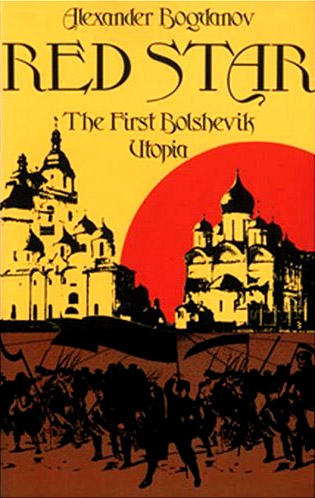Alexander Bogdanov: Red Star: The First Bolshevik Utopia (1908–) [FR, EN, DE]
Filed under fiction | Tags: · communism, marxism, proletariat, science fiction, utopia

A communist society on Mars, the Russian revolution, and class struggle on two planets is the subject of this arresting science fiction novel by Alexander Bogdanov (1873–1928), one of the early organizers and prophets of the Russian Bolshevik party. The red star is Mars, but it is also the dream set to paper of the society that could emerge on earth after the dual victory of the socialist and scientific-technical revolutions. While portraying a harmonious and rational socialist society, Bogdanov sketches out the problems that will face industrialized nations, whether socialist or capitalist.
The book also includes Engineer Menni, a historical novel about the social revolution on Mars, first published in 1913, and the poem A Martian Stranded on Earth, first published as a supplement to the second edition of Red Star in 1924, about a Martian who has reached Earth but is unable to return to his native planet. where mankind has attained a superior level of communist civilization.
Edited by Loren R. Graham and Richard Stites
Translated by Charles Rougle
Publisher Indiana University Press, 1984
ISBN 0253173507, 9780253173508
257 pages
Reviews: Andy Cunningham (Socialist Review), Paul Josephson (Technology and Culture).
L’Étoile rouge (French, 1913-14, HTML, added on 2014-3-27)
Red Star (English, trans. Charles Rougle, 1984)
Der rote Planet (German, undated, HTML, added on 2014-3-27)
See Monoskop wiki for further writings of Bogdanov.
Comments (6)Francis Spufford: Red Plenty: Inside the Fifties’ Soviet Dream (2010)
Filed under book | Tags: · 1950s, 1960s, communism, cybernetics, economy, engineering, history of computing, mathematics, politics, science, soviet union

This book is about the moment in the mid-20th century when people believed that the state-owned Soviet economy might genuinely outdo the market, and produce a world of rich communists and envious capitalists. Specifically, it’s about the last and cleverest version of the idea – central planning via cybernetics – and about how and why, in the 1960s, it failed. To give the economics some human depth, Red Plenty generates a miniature Soviet Union on the page, peopled by scientists and politicians, fixers and managers, dreamers and cynics.
Publisher Faber & Faber, 2010
ISBN 0571269478, 9780571269471
356 pages
EPUB (updated on 2019-11-20)
See also:
Red Plenty Platforms, essay by Nick Dyer-Witheford, Culture Machine 14, 2013
Red Plenty: A Crooked Timber, collection of essays inspired by the book, 2012
Geoff Waite: Nietzsche’s Corps/e: Aesthetics, Politics, Prophecy, or, the Spectacular Technoculture of Everyday Life (1996)
Filed under book | Tags: · aesthetics, communism, esotericism, everyday, left, life, philosophy, politics

“Appearing in 1996 between two historical touchstones—the alleged end of communism and the 100th anniversary of Nietzsche’s death—this book offers a provocative hypothesis about the philosopher’s afterlife and the fate of leftist thought and culture. At issue is the relation of the dead Nietzsche (corpse) and his written work (corpus) to subsequent living Nietzscheanism across the political spectrum, but primarily among a leftist corps that has been programmed and manipulated by concealed dimensions of the philosopher’s thought. If anyone is responsible for what Geoff Waite maintains is the illusory death of communism, it is Nietzsche, the man and concept.
Waite advances his argument by bringing Marxist—especially Gramscian and Althusserian—theories to bear on the concept of Nietzsche/anism. But he also goes beyond ideological convictions to explore the vast Nietzschean influence that proliferates throughout the marketplace of contemporary philosophy, political and literary theory, and cultural and technocultural criticism. In light of a philological reconstruction of Nietzsche’s published and unpublished texts, Nietzsche’s Corps/e shuttles between philosophy and everyday popular culture and shows them to be equally significant in their having been influenced by Nietzsche—in however distorted a form and in a way that compromises all of our best interests.
Controversial in its “decelebration” of Nietzsche, this remarkable study asks whether the postcontemporary age already upon us will continue to be dominated and oriented by the haunting spectre of Nietzsche’s corps/e. Philosophers, intellectual historians, literary theorists, and those interested in western Marxism, popular culture, Friedrich Nietzsche, and the intersection of French and German thought will find this book both appealing and challenging.”
Publisher Duke University Press, 1996
ISBN 0822317192, 9780822317197
xii+564 pages
Review: Douglas Kellner (Illuminations, (2)), Ricardo Dominguez (Thing, 1996), Carl Pletsch and James A. Winders (Modernism/modernity, 1998), Tracy B. Strong (New Nietzsche Studies, 1998), Paul Bishop (Modern Language Rev, 1999), Richard E. Joines (Rethinking Marxism, 2001, (2)).
See also Pierre Klossowski’s Nietzsche and the Vicious Circle (1969–)
Comment (0)
